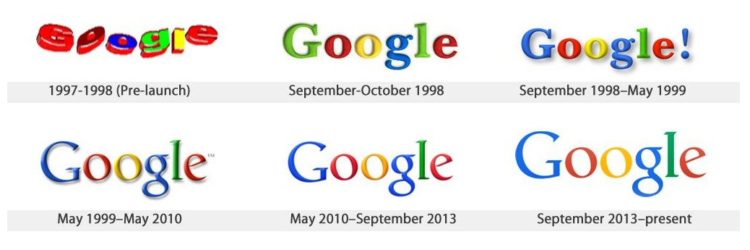You know you’ve made it as a brand when your company name becomes an actual verb in the Official English Dictionary. No one says: "I’ll just Bing that"; "I’ll Ask Jeeves"; or "Our DuckDuckGo rankings are through the roof!".
Instead, "Just Google it" has become synonymous with the internet itself, exclaimed by everyone from your college professor to your car mechanic. Google is more than just a brand. More than just a search engine. It’s the only gateway to the internet itself and its wealth of information for over 90% of us (as of 2021 at least).
Whether you’re a fan of their monopolistic market share on such an essential service or not, Google is a brand you simply cannot ignore.
So what are the secrets behind their success, and what branding lessons can be learned by the everyday marketer looking to inspire their own brand strategy? Much like our similar commentary pieces on Apple, Amazon, and Coca-Cola, we’re taking a deep dive into what makes Google such a successful brand.
Branding lessons from Google
Credibility with your customers comes first
The original mission of Google’s founders Sergey Brin and Larry Page to bring order with its budding search engine to what was quickly becoming a chaotic, exponentially growing mass of information during the “Wild West” of the internet was a ballsy move. But the company understood, long before many of their fellow competitors, that internet users need to trust the information they receive, building algorithms that put user experience at the center of their strategy.





Keywords, search terms, backlinks, relevant page titles, and HTML metadata are run-of-the-mill features of what a search engine utilizes nowadays. But back then, these search engine components were pioneering a new method of navigating the web, delivering relevant content for specific searches in an instant (functionality that serves as the basic backbone of Bynder’s DAM too, coincidentally).
Yet Google didn’t rest on their laurels after witnessing such meteoric success over their early-days search engine competitors. To this day, they are relentless in striving to build and maintain trust with their users—whether it’s promoting a privacy-first web or branching out in offering additional services such as Maps or Drive, products many of us depend on daily.
While products and services go in and out of style, credibility is always important. Focus on building trust with your customer base via whatever solution you offer, and it’ll be more impactful than anything your marketing budget can cook up.
Create a culture of innovation that embraces failure
Despite Google’s unrivaled success with a wide range of technological innovations, they’ve certainly had their fair share of flops (over 200 in fact, conveniently and hilariously listed on the 'Google Graveyard' at: killedbygoogle.com). But more interestingly, Google is perhaps one of few companies likely to celebrate their failures and advocate a working culture that doesn’t shy away from making mistakes. They’ve been lauded for pushing a real culture of innovation across the brand, popularizing the '70/20/10 model' since its early days, meaning:
70% of projects are dedicated to core business
20% of projects are related to core business
10% of projects are unrelated to core business
Despite being one of the largest organizations in the world that know exactly where the business value lies, they’re committed to continuous innovation across the organization—regardless of core business success.
The story of innovation has not changed. It has always been a small team of people who have a new idea, typically not understood by people around them and their executives.Eric Schmidt
Chairman at Google
Too often, today’s organizations pigeonhole people and resources into siloed department structures and "play-it-safe" working mentalities that obsessively focus efforts on short-term, quarterly-measured quantitative business value.
Instead, imagine if more brands allowed their employees to devote at least 10% of their time experimenting with anything-goes, sky’s-the-limit thinking that goes beyond the scope of their role, department, and 'core business' goals. While you may create your fair share of canned ideas and dead-end projects, you’re creating a collaborative culture of innovation that leaves employees feeling valued, creatively challenged, and receptive to your brand’s next big idea. Something that could bring 10x more value than what may potentially be lost from all those “failed” projects along the way.
At Bynder’s annual branding conference, OnBrand, back in 2017, Steve Vranakis of Google Creative Lab shared some of the creative innovations the company has employed to tackle some of society’s most pressing issues:
Balance brand consistency with brand flexibility
While it’s something that can be overlooked when you’re focusing on the product or service itself, the visual identity of your brand can be invaluable when it comes to leaving a lasting impression on your audience. Humans are visual creatures, and recognition is key. As for Google, they haven’t fallen into the trap of launching multiple rebrands aka ‘brand makeovers’ in an attempt to obtain and appeal to new audiences—a strategy often employed in the tech world as a brand’s products and services evolve.
With its iconically simple multicolor logo, Google has kept (more or less) the same visual design since its inception in 1998. Not only has it fostered long-lasting brand awareness, but it also builds credibility over its ever-expanding product portfolio.

The simplicity of Google’s logo and persistence with its multicolor branding has allowed the company to deftly stamp its brand presence across a range of different services, building a degree of brand cohesion over a list of products that at face-value can often have nothing in common other than its shared brand identity.
Despite this degree of uniformity, they’re certainly not rigid and regularly employ an element of playfulness within their visual branding in order to tap into the trends of the day and seamlessly integrate their brand into popular culture. From global sporting events to the birthdays of famous public figures, the various Google Doodle features on the homepage have evolved from simple typeface tweaks to increasingly complex interactive games—an homage to Pacman’s 30th anniversary back in 2010 proving to be one of the most popular among users. In fact, it’s still available to play by clicking the image below (go on, we’re not judging—just make sure your boss isn’t lurking behind you.)
When it comes to Google’s track record of acquiring other companies—a process that can all too easily become a messy and chaotic affair from a branding perspective (FYI here’s our solution for that)—they’ve had a knack for recognizing the importance of established branding and again knowing when to refrain from an unnecessary rebrand.
After acquiring YouTube for $1.65 billion back in 2006, they likely knew the rapidly-growing video streaming platform would reap no benefit from a drastic change to its logo and branding to make it more...well, Google-y.
Adopting an "if you can’t beat them, buy them" mentality to the competition after their own Google Videos failed to establish itself as a viable alternative, they could’ve easily played the sourpuss and flexed their brand muscles over their competitor-turned-partner. Rather, the "if it ain’t broke, don’t fix it" approach to YouTube’s branding post-acquisition proved to be a sound decision. And you don’t need any more proof than the success and influence YouTube has in 2021, firmly entrenched as the ‘Google’ of video content.
UX is king
It’s safe to say that Google knows a thing or two about user experience. Hell, they practically invented the rulebook on it from an SEO perspective. From loading performance and security to mobile-friendliness and interactivity, Google sets the standards for 'great user experience', and whether they like it or not, businesses must fall in line if they’re to climb the search ranking ladder and get their websites in front of consumer eyes.
As a guiding principle, Google describes their UX approach with the mantra: "Focus on the user and the rest will follow", outlining an attitude that every decision should serve the users first, and everything else second — including their own bottom-line. Whether it’s to be taken literally or not, you can’t argue that a quality user experience underpins the essence of much of Google’s services. How reliant are we on Google Maps to get around? Or to answer a random question that your brain won’t leave alone when you’re in bed at 3AM? Google Translate alone has been transformative the world over in breaking down language barriers between us in the online and offline world—and half the time we don’t even realize when a website has just been translated by Google for your reading pleasure.
We’ve become so dependent on Google’s services in our day-to-day lives, that we’re completely jaded by it, forgetting just how reliant we are on their technologies and services. When it comes to UX, there’s arguably no better compliment than that.
Quality UX depends on quality data
"Be data-driven": a common cliche you’ve likely heard a thousand times before. But it’s a lesson all modern marketers must learn if they’re to remain competitive in the digital age. As for Google, to say that they’re data-driven would be a massive understatement. Data is the backbone of each and every one of their products and services, and the key ingredient in delivering the exceptional UX touched upon above.
Of course, Google not only leverages data for their own purposes, but they enable us marketers to tap into the power of data ourselves via their Adwords and Analytics tools.
But how exactly can today’s marketers get inspired by Google’s approach to data? Here are a few pointers to get you started:
- Installing Google Analytics on your website is a must
- Find your focus areas: Which data points and metrics are important for your business? Try to focus on metrics you can analyze consistently over time — think new vs returning visitors or bounce rates on key landing pages
- Set up automated reports with both high-level and granular information
- Create a spreadsheet or table for tracking the metrics, providing a bird’s eye view of digital marketing performance for you and your team
- Devote time to analyzing and learning from your data. The results should be used to inform, enhance and measure your broader sales and marketing activities





















